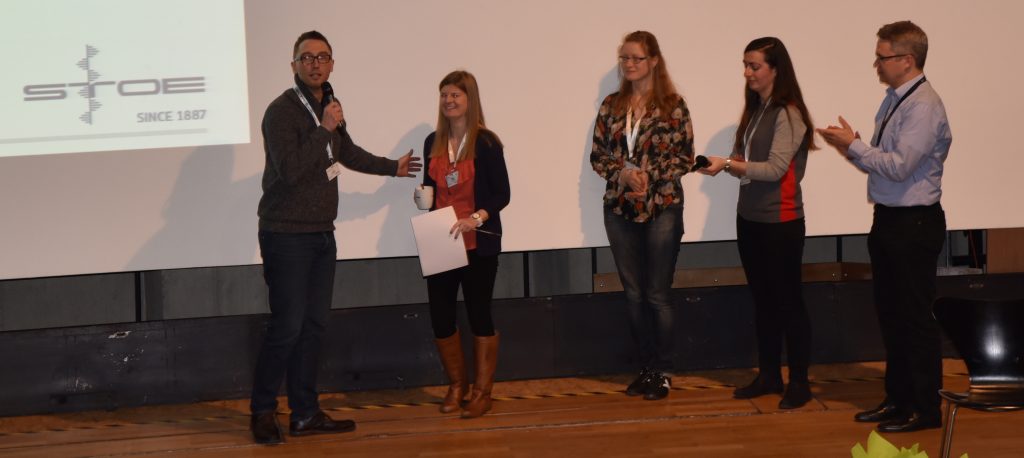During the annual DGK meeting in Stuttgart 2016, the Young Crystallographers hold their lightning session and a poster session. A small committee of established scientists selected the three best posters. One of these winners is Manuela Gorgel, besides Gregor Hofer and Sandrina Meis.
Manuela finished her studies in Molecular Life Sciences at the University of Lübeck in 2011 in the Carlomagno Group. She was working on NMR Assignment and Nucleic Acid Binding Properties of the PAZ Domain of the Human Argonaute Protein 2. Her master studies were followed by a Ph.D. position at Aarhus University in the Nissen Group. The title of her Ph.D. project is Crystallographic and Electron Microscopy Studies of Electrically Conductive Nanowires which she finished by the end of 2014. She is currently a post-doc at the Ludwigs-Maximillians-University working in the group Crystallography on DNA Repair Proteins. Manuela was successful throughout her research career. Both, her bachelor and master thesis, were awarded as the best in Molecular Life Sciences. Her Ph.D. thesis is currently nominated for the best Ph.D. thesis from the Danscatt Society, which is still pending [I’ll cross my fingers for you -Ed.].
Can you tell us a little bit about the research topic of your PhD thesis and your method(s) of choice for your investigations?
In my Ph.D., I have been working with bacterial nanowires from Shewanella oneidensis. These nanowires are long extracellular filaments that can transfer electrons – and thus electricity – between cells and from cells to metal surfaces. Shewanella can use such metal surfaces, including iron and uranium, instead of oxygen as electron acceptors. This is a very exciting phenomenon, but also brings along some problems: Metals are highly insoluble and, unlike oxygen, can not easily enter the cell. Therefore, the electrons need to be transferred to the outside to the metals. Shewanellas do that analogous to how we transfer electricity from the plug to the TV, namely via their own little cables – so-called nanowires.
In order to understand and apply these natural cables in the future, I studied the composition and the structure of nanowires from Shewanella using biochemical methods, EM and crystallography. Naturally, crystallography allows us to tell how the nanowire subunits look in 3D and EM enables us to build up a whole nanowire, so clearly these were my two methods of choice. At the same time, we needed to produce nanowires and detect the subunits by mass spectrometry and western blotting.
Are you more interested in Shewanella oneidensis or in the nanowires?
Well, that is a difficult question. I never thought about Shewanellas and nanowires separately. I am interested in how Shewanellas form nanowires and how the nanowires transfer electricity. Also, of course how Shewanella regulates that process. You see, they are very much connected, so nanowires and Shewanellas usually come together. Nevertheless, one might see nanowires as a detailed part of the Shewanella bacterium and sure, then I am more interested in nanowires than Shewanellas as a whole.
What was the biggest challenge of your research project so far and how did you solve it?
The biggest challenge has probably been that Shewanellas and nanowires are a new research field. That means that not much is known yet and you can not use information from other groups, simply because it is so rare. So I really had to start from scratch, not only from making the protein and getting crystals, but also from growing nanowires and analyzing what is inside. Already the first step, making the nanowires, turned out to be difficult. So I visited the group of Dr. Mohamed El-Naggar at the USC [University of Southern California -Ed.] and learned from our collaborators how to do it. Next, the analysis of nanowires was also not that easy: I had to figure out how to break the filaments apart into the individual subunits, get specific antibodies and get good mass spectrometry data. Here, I had great support from my supervisor and colleagues in Aarhus, so in that case good team work was the solution. The last challenge was that we had a difficult data set for our crystal structure. Here we worked really hard, spent a lot time in the computer rooms, tried many different combinations and not to forget had good beamline support from Manfred and Uwe at BESSY.
What was your greatest success with your research project so far?
For me personally, the greatest success was clearly when I was presenting my work at the IUCr in Canada in 2014. I was speaking in a methods session together with Wayne Hendrickson and Armin Wagner [Columbia University and Diamond Lightsource -Ed.], so I was very excited and also very nervous. Everything went very well and I got a lot of positive feedback afterwards. George Sheldrick approached me and we processed some of my data together. That was so cool, I really enjoyed that day!
Have you had any special way to prepare your poster?
No, not really. I just thought I wanted to make it appealing to all crystallographers, not only to protein people. So I tried to make it as simple as possible while keeping the important scientific messages. And with a lot of pictures of course!
From left to right: Oliver Pecher, Manuela Gorgel, Melanie Nentwich, Julia Dshemuchadse, Martin Fark
Picture by Frank Adams, Stuttgart University
